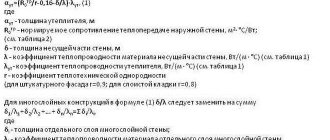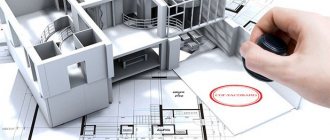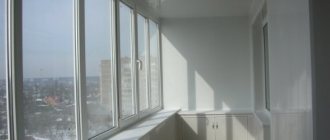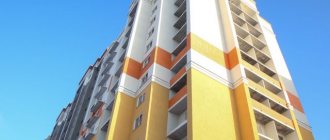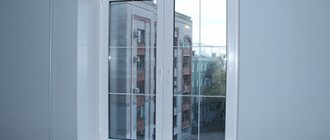Citizens often wonder about the inclusion of balconies in the total area of the apartments they purchase. There are contradictions in the legislation regarding this point. Controversial issues are associated with different statements of standards in the Housing Code and SNiPs. At the same time, the issue of calculating living space is important when the buyer needs to register an apartment. The final cost depends on the correct calculation of the living space. Also, how much a citizen will ultimately pay for utilities depends on the footage.
What does the square footage of an apartment affect?
When purchasing a home, it is important to accurately calculate its square footage. This value affects such indicators as:
- final price of housing;
- amount of heating payments;
- the amount of land tax;
- calculation of the amount of housing tax;
- determining the amount of tax deduction;
- calculation of 1 m2 of housing during the procedure for relocating residents from a dilapidated building;
- determination of housing accounting standards;
- calculation of living space transferred under a social tenancy agreement;
- calculation of the amount of gratuitous social payments from the state budget.
Footage is also necessary when drawing up deeds of transfer, drawing up inspection reports for living spaces, drawing up an assessment report, and allocating rooms in dormitories. This indicator is required when drawing up a registration certificate for housing and during the redevelopment procedure. This parameter is always necessary when selling real estate.
Is the loggia included in the total area of the apartment: how to take it into account when buying a home
How do area reduction factors for balconies and loggias work in practice? If the developer sells an apartment of 50 sq. m (including a balcony of 6 sq. m) at a price of 50,000 rubles per sq. m. m, then its cost is 2,500,000 rubles. If we take into account the coefficient, the balcony footage is reduced to 1.8 square meters. m, and the price is up to 2,410,000 rubles, respectively. The amount saved is noticeable for the buyer and can be used for personal needs or renovation work in the apartment.
Often, residents carry out redevelopment on their own, after which they do not legitimize it in any way or go to court to have their actions declared legal. However, the easiest way is to obtain permission from the local administration, after which you can safely begin redevelopment.
In order for a room to meet the established requirements, it must have certain parameters: Be isolated and separated from other territories That is, have a separate exit to the staircase Be located in an apartment building With more than two apartments The apartment must have access to common areas in an apartment building house To have one or more rooms - The square footage of the apartment also includes additional premises that make it possible to provide normal living and sanitary conditions for the residents.
SNiP standards for balconies
The provisions regarding the calculation of living space are regulated by SNiP dated 2003. There are also separate rules in the technical regulations adopted under the Law of December 30, 2009, designated 384-FZ. This law is considered a priority.
Some points regarding the calculation of living space sizes are contained in the Instructions adopted by order of the Ministry of Land Construction, number 37, dated August 4, 1998.
How is a balcony calculated in the total area of an apartment according to SNiP
SNiP does not contain precise instructions regarding whether a balcony is included in the total area of the apartment. In clause B.2.2 of the Appendix to SNiP 2003 there is a definition of the total area of the dwelling. It includes heated and unheated rooms. The latter includes the balcony area along with loggias. In this case, the footage of unheated zones is calculated with a reduction factor.
In paragraph 3.37 of the Instruction, number 37, it is stated that the total area of housing includes the footage of its premises, as well as balcony space and loggias. Verandas, storage rooms and terraces are also taken into account. The size of these premises is calculated using a reduction factor.
The 2nd Appendix to SNiP under number 2.08.01-89 also states that the total living space includes not only the area of the premises, but also balcony areas and loggias. The latter are also taken into account according to approved reduction factors.
Important! Building regulations regulate that balcony areas and loggias are included in the total living space.
Does the balcony belong to the residential part of the apartment?
SNiP distinguishes between the total living space of apartments and their living area. All SNiPs indicate that the housing area includes only premises where heating is installed, as well as the footage of all residential and auxiliary areas, but without balcony areas and loggias. The latter are classified as unheated areas of apartments. Also, Instruction number 37 does not include unheated premises as a residential area.
Attention! Current SNiPs in Russia do not classify balcony areas and loggias as living space. It includes only rooms.
How to calculate: is a loggia or balcony included in the total area of the apartment?
The issue of heating is decided individually. If radiators are installed, and in the cold season you can spend time on the loggia, then this space is classified as heated. This, of course, affects the amount of utility bills. Each square meter of additional premises will be included in the receipt for housing and communal services.
According to Appendix B (clause 2.2), supplementing SP 54.13330.2011 “Residential multi-apartment buildings”, the total area of an apartment should be understood as “the sum of the areas of its heated rooms and premises, built-in closets, as well as unheated premises, calculated with reduction factors established by the rules technical inventory". The same Appendix states that the purpose of such a calculation is statistical accounting and that same technical inventory.
- interaction between government agencies and citizens - provision of housing under a social rental agreement, accounting for such premises;
- interaction between owners and operating companies - charging for utility services;
- management of an apartment building - its renovation, creation of an HOA, etc.
For example, a developer sells apartments of 100 m2 for 60,000 rubles per square meter. The balconies of these apartments are 4 m2, and the loggias are 6 m2. The total cost of such housing is 6,000,000 rubles. If you apply a reduction factor, you will get different numbers. The total area of the premises will be 96 and 94 m2, and the summer extensions will have a reduction factor of 1.2 and 3 m2. After recalculation, the main premises will cost 5.76 and 5.64 million, and the extensions will cost 72 and 180 thousand, respectively. The correct price of the apartments will be 5,832,000 and 5,800,000 rubles. If you apply the correct calculations, you can save up to 200,000 on your purchase.
Article 15 of the Housing Code of the Russian Federation
This law contains the concept of residential premises. It is understood as an isolated type premises classified as real estate. Moreover, it will be considered residential if people can live in it.
This law also specifies what is included in the total living space. This is stated in Art. 15 of the law, namely, in part 5. According to the Housing Code, the total footage of a residential premises includes the sum of the areas of its parts. It also includes auxiliary premises. The exception is balcony areas, loggias, as well as terraces and verandas.
Note! The residential complex does not include balcony spaces and loggias among the total living space.
Is the area of the loggia and balcony included in the total area of the apartment?
The total area as the main characteristic of a residential premises is the main criterion when paying for utilities and determining the market value of housing. Considering that the maintenance and purchase of housing cost a lot of money, you need to know the basic legislative acts of housing and understand the question of whether a loggia should be included in the total area of the apartment. Constant changes in the legislation of the Russian Federation ambiguously interpret the provisions on the estimated value of housing that is in operation or present on real estate market.
- According to the shared construction agreement, the developer must include in the deed a description of all the premises of the apartment included in the design documentation for the construction of the house.
- As you know, the construction of residential buildings in our country is carried out according to SNiP standards. They, in turn, refer to the housing code, in the paragraph determining the inclusion of premises in the total area.
The difference is 4.5 sq. meters, for which the developer received extra money, forced the buyer to go to court. The developer, relying and referring to various rules and laws, refused to accept the explanations of the regional BTI, which, for its part, justified the situation in accordance with the current Housing Code of the Russian Federation.
The rules for the provision of utility services to citizens of the Russian Federation provide for payment for heating network services based on the total living area without taking into account cold loggias. In the case where the loggia has become heated and the redevelopment has been officially permitted, the total area of the apartment increases. In this regard, the payment for thermal energy consumption also increases.
However, when assessing the area of a balcony or loggia, reduction factors of 0.3-0.5 are applied, since this area is not equivalent to residential (rooms, bedroom, hall, etc.). At the same time, the mere presence of a balcony always slightly increases the cost of the apartment, as well as its condition - glazing, double-glazed windows, insulated floors, etc.
Contradictions between the RF Housing Code and SNiP
There is a discrepancy between the requirements contained in SNiPs and the Housing Code. According to the first, the area of balcony premises is taken into account as part of the total living space, but with the mandatory inclusion of a reduction factor; according to the second, balcony areas do not belong to the general footage of apartments.
SNiPs regulate the relationships that arise between shareholders and builders of apartment buildings (MKD).
Construction companies, when selling apartments, are required to evaluate their footage together with balcony rooms, taking into account the reduction factors provided for them. They will affect the cost of all housing.
Housing complexes regulate only those relationships that arise between home owners and management companies. For this reason, the residential complex does not include balconies with loggias among the general footage of apartments.
Important! The residential complex has the status of a federal law. Its legal force is higher than that of SNiPs. Despite the obvious contradiction of these acts, citizens, developers and management organizations must be guided by the provisions of the Housing Code of the Russian Federation.
Therefore, one should rely on the fact that balcony rooms are not part of the total footage of the home.
Is a balcony or loggia included in the total area of the apartment?
To determine the square footage of a room, you need to measure the length of the opposite walls and multiply them. To obtain the correct result, measuring instruments should be placed at a height of 1-1.5 meters from the floor surface. Partitions are not allowed to be included in the total area.
- In the Housing Code of the Russian Federation, in Art. Figure 15 shows the principle for calculating the size of an apartment. Even auxiliary premises are supposed to be included in the footage, but do not take into account the balcony with a loggia.
- SNiP states that the entire area consists of zones with and without heating batteries. Moreover, a reduction factor must be applied to unheated ones.
- The instructions for accounting for housing stock speak of a single area as the sum of parameters for all premises without exception. And the cost of real estate is calculated using coefficients for a loggia - 0.5, a balcony - 0.3.
All information about the parameters of the apartment, which is based on the construction project and measurements by BTI specialists, is displayed in the acceptance certificate for the object. The footage of balconies must be indicated in the papers, therefore, if desired, the indicators can be compared.
Services from public utilities are provided according to the relevant rules that are approved by current legislation. Heating services calculate fees according to the square footage of the apartment, without taking into account the square footage of balconies and loggias. According to the rules of Art. No. 354 of the Housing Code of the Russian Federation, contracts with public utilities must contain the following information:
But, as a rule, the operating organizations are not to blame. After all, rent is calculated on the basis of documentation provided by the owners. It is from the cadastral passport that the housing office takes the number of square meters and multiplies it by the tariff to calculate payment. This document is issued after signing the acceptance certificate with the construction organization.
Agreement with the developer
It makes no sense for developers to meet buyers halfway and strive to help them save money and reduce material costs. Therefore, every construction company tries to insure itself in advance. This comes down to the fact that there will probably be a clause in the contract that states that there may be a slight difference between the projected and actual area of the apartment. If this fact is discovered, the buyer will not make a claim. Often, buyers agree and sign documents in advance. To learn how to correctly draw up an agreement with a developer and make amendments, watch this video: When it comes to the understanding that the overpayment is quite large, people who bought housing turn to representatives of the law. Lawyers explain that the legislation of the Russian Federation strictly states that only premises that are not a passageway can be considered residential. In addition, it is property that is not related to movable property. According to experts, it is suitable in all respects for permanent residence. This definition can be obtained in accordance with all established standards corresponding to sanitation standards and technical rules.
Algorithm for performing calculations
The shapes of balconies are very diverse. They are rectangular, beveled, round, elongated.
It is not difficult to measure a rectangular or square structure, but calculating the area of a balcony of complex shapes is much more difficult. The last task can be made easier by dividing the required space into simple geometric shapes. For example, a bay window can be divided into a triangle and a rectangle.
- The first thing to do after this is to carefully measure the sides of the resulting figures using a tape measure or rangefinder.
- Draw a sketch of the room or its drawing on paper and mark the dimensions of all the figures on it.
- It is recommended to perform all calculations related to calculating area using a calculator.
- Calculate the area of the figures in the drawing.
When calculating these quantities, formulas known from the school geometry course are used. Let's remember how to calculate the area of basic geometric shapes.
- Square. Knowing what the length of its side is, you need to multiply this value by yourself.
- Rectangle. In this case, you need to know the values of two parameters - length and width. The S of a rectangle is calculated by multiplying them.
- Triangle. To calculate S of a triangle, in addition to the value of the base, you also need the value of the height, that is, the perpendicular lowered onto it from the vertex, then the required value can be calculated by determining half of their product.
- Circle. Its radius is squared and the result is multiplied by π - a number equal to 3.14. True, it is worth noting that it is much less common to divide the space of a room into circles.
The results obtained are added up.
For reference! However, it is important to know that when calculating the total apartment area, the result obtained is first multiplied by the balcony reduction factor
- for glazed - the reduction factor is 0.8, that is, 80% of its area is taken into account in the general apartment;
- unglazed - 0.3, that is, only 30%;
- for an unglazed loggia – 0.5 (50%);
- glazed – 1.0 (100%).
Legal relations with the developer
To save money when participating in shared construction of an apartment building, you need to carefully study the text of the concluded agreement. It states:
- cost of 1 sq. m;
- square footage of the apartment taking into account the reduction factor;
- the final price for the apartment.
The general square footage specified in the contract must also be checked with the technical documents provided by the developer. This is important not only for saving money, but also for further registration of ownership and obtaining a technical passport for housing.
In practice, there are often situations when, based on incorrect data, the balcony is included in the total footage of the apartment and the owner has to pay more for utilities. Care when concluding a contract and preparing a technical passport will save you from clarifying relations with utility services.
If, before registering property rights, you saw that in the transfer and acceptance certificate of the apartment a loggia or balcony was included in the total area, contact the BTI. Based on the Housing Code of the Russian Federation, they will make the appropriate calculations, with which it will be possible to obtain a certificate of ownership without fear.
If, when participating in shared-equity construction of an apartment building, reducing coefficients were not applied, you can go to court. There are many cases in judicial practice when the developer had to return to the buyer the money overpaid “for the balcony”. In some of them, the plaintiffs' demands for moral compensation were also satisfied.
Tools
To calculate the area of a balcony, ordinary tools are used - a ruler, a tape measure, but to get the most accurate results, it is recommended to use a laser range finder.
- A tape measure is a well-known flexible steel tape that is wound into a box-case using a simple mechanism. The instrument has a special saddle. It is necessary so that the tool can be hooked onto the object that is going to be measured. To measure, use a tape measure of 200-500 cm. Since you need to calculate the area of the balcony as accurately as possible and you don’t need extra centimeters, the tape measure cannot be bent when measuring, it should lie flat on the surface.
- The rangefinder is a higher class tool. It is more reliable and provides less measurement error. The operation of an electron-optical instrument uses the properties of a laser beam. In particular, a laser rangefinder allows you to take measurements in hard-to-reach places in height, depth, and even impassable areas. In addition, measurements can be carried out without a partner.
Basic principles of internal measurements
A room does not always have equal geometric proportions, that is, in practice, quite often parallel lengths can have a difference of several centimeters or more. Therefore, it is recommended to always use a larger length in calculations.
Along the plane of each surface, you need to add 1–2 cm to the length and width, since the probability of defects in building materials is quite high, and in any case it is easier to cut off the excess than to seal the cracks.
And one more thing - we must not forget about the identity of the calculations, that is, if the unit of measurement for length and width is a meter, and the area should be in square meters.
Read more on the topic:
- How to make external slopes with your own hands
- Liana - a simple but functional ceiling dryer
- Silicone grease for rubber seals: importance of use and types
- Lubricating internal fittings on double-glazed windows: why is it needed and with what composition
- Wooden window frames: features and disadvantages
